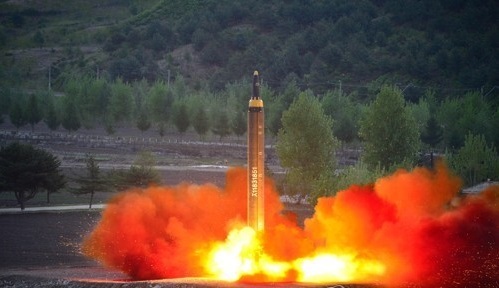The United States military stationed in South Korea has informed the host country of its detection of a recent North Korean missile launch, but important facts were omitted in the information sharing, sources said Wednesday.
Following North Korea's ballistic missile launch on early Sunday, the US Forces Korea informed the South Korean military that the TPY-2 radar component of the recently stationed Terminal High Altitude Area Defense system detected the North Korean missile, the intelligence sources said. The notification was made verbally over the phone, they said.
However, key facts involving the detected launch were omitted, including the falling speed of the missile or the shape of the warhead the missile was carrying, according to the sources.
 |
This photo, released by the North's Rodong Sinmun daily on May 15, 2017, shows the launch of the Hwasong-12 missile the previous day. (For Use Only in the Republic of Korea. No Redistribution) (Yonhap) |
"Currently, (the South Korean military) is unable to have real-time access to the detection data of the THAAD radar because the system to share real-time data with the USFK is still under construction," a defense official said on condition of anonymity. South Korea has "been informed only of the fact that the North Korean missile was detected over the phone and through word of mouth."
South Korea and the US are currently building a data-link system to share information gathered by the US-controlled THAAD radar and the Green Pine missile defense radar operated by the South Korean military. But the system isn't expected to be ready for operations until late this year.
The day after the launch, North Korea claimed the fired missile, called Hwasong-12, reached an altitude of 2,111.5 kilometers, suggesting that it was a new type of intermediate-range ballistic missile. The missile flew 787 km, the North argued.
The South Korean military has said that the descending rate of the Hwasong-12 missile was somewhere between Mach 15 and 24, which falls short of the minimum falling rate of Mach 24 that any intercontinental ballistic missile would have recorded.
Another defense official also indicated that the missile fired on Sunday also fell short of succeeding in re-entry, a key ballistic missile technology the North is reportedly struggling to achieve.
The allies delivered key components of the THAAD battery to the host county of Seongju last month, including the radar and interception missile launchers, and the initial operational capability of the air defense system has been achieved. (Yonhap)








![[Today’s K-pop] Blackpink’s Jennie, Lisa invited to Coachella as solo acts](http://res.heraldm.com/phpwas/restmb_idxmake.php?idx=644&simg=/content/image/2024/11/21/20241121050099_0.jpg)